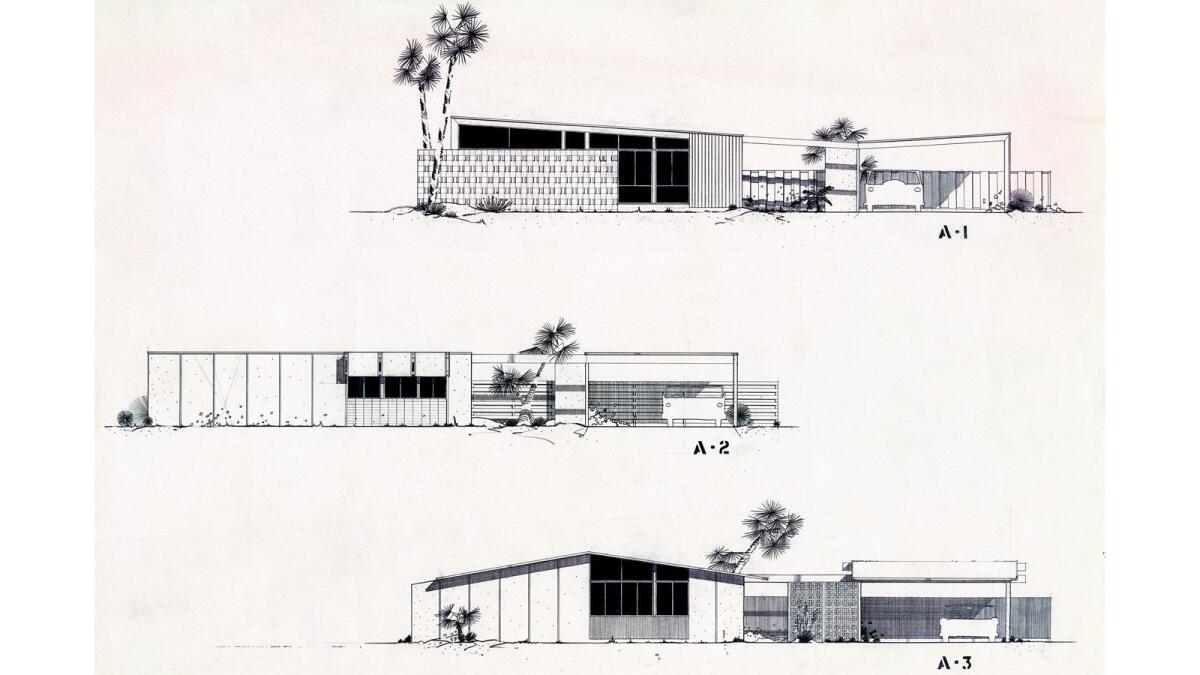The man who gave Palm Springs its signature style -- and proved all his critics wrong

An interview with architect William Krisel, the man who gave Palm Springs its signature look.
- Share via
You may not recognize William Krisel’s name, but you know his iconic Palm Springs Midcentury Modernist houses. Open to their surroundings and light on the landscape, their broad butterfly, flat or pitched roofs set atop courses of clerestory windows seem to float. Well understanding that these homes were about a casual, outdoor lifestyle, Krisel used every opportunity to direct the eye up and out to views of mountains, pool, palms and brilliant blue sky.
If Modernism defined the midcentury residential world of Palm Springs, then Krisel’s work defined Palm Springs residential Modernism.
His exuberant designs for vacation homes, some with flaring butterfly roofs, all with wide expanses of roofline windows and glass walls, clear colors and signature detailing, rang with postwar optimism and a joie de vivre as infectious today as it was in the 1950s. This master of affordable yet architecturally serious tract housing gave California’s rising middle class a new vision of a life of second-home weekend leisure once seemingly unattainable.
Celebrated in his day, Krisel, now 91, has reached a new level of appreciation. With this month’s publication of “William Krisel’s Palm Springs: The Language of Modernism,” Krisel for the first time is the sole subject of a book, which will be launched at a party with the authors on Feb. 14 during Palm Spring Modernism Week, Feb. 11-21. The event will be held, appropriately, at one of Krisel’s seminal Twin Palms houses.
MORE: Find more events honoring Krisel, and additional details about Modernism Week here:
Organized as a series of topical monographs by historians, architects and others, the hardcover was put together by Krisel homeowners and aficionados Chris Menrad and Heidi Creighton, with heavy input from Krisel himself. It’s not “a scholarly work,” per se, Menrad says. “It’s very accessible. His work is extensive, and hopefully this is the first step of putting it all in print.”
That he isn’t the subject of much curatorial dissection suits Krisel just fine.
“When they start doing that with my work, I don’t like it,” he said during an interview at his Los Angeles home. “When I put my pencil on the board, that’s what comes out. I do it because I feel it.”
PHOTOS: More images of architect William Krisel’s style
Krisel designed about 40,000 living units, including larger custom homes, in Palm Springs and elsewhere, but it is the roughly 1,200 modest homes he designed between 1957 and 1963 for builder-developers George and Robert Alexander that define his “language” of Modernism, as he puts it, and his legacy.
More than anything, Krisel was a brilliant pragmatist who knew how to couple architectural integrity with an affordable bottom line. “Their main interest was to make money,” he says of the Alexanders, “and my interest was to do good design. In order for them to do my work, I had to come up with a design that was less expensive than the dingbats they were building.”
And Krisel knew these tract homes had to capture buyers’ imaginations at first sight.

Renderings of William Krisel-designed residences at Racquet Club Road Estates in Palm Springs (1959). The book “William Krisel’s Palm Springs: The Language of Moderism” contains a number of such images, as well as monographs about Krisel’s work.
Using inexpensive industrial and prefabricated materials in new ways, he insisted that the houses be individualized, achieving in the early 1,600-square-foot Twin Palms tract, for example, eight different looks by rotating interior floor plans and applying different roof styles, differently patterned concrete-block walls, and color schemes. Every house had a pool and air conditioning.
A skilled artist, Krisel’s evocative three-dimensional renderings, complete with people lounging by the pools, sold a blissful lifestyle as much as a structure. And yet, when it comes to the desert, “I wouldn’t like to live there,” he says, “but I like it as a locale for my architecture.”
With his archives now housed at the Getty, Krisel wryly recalls that his tract work was initially “shunned” by the American Institute of Architects, of which he was a member. They considered it “degrading” for him to do and “not really architecture,” Krisel recounts.
Time has proved them wrong.
The smallest, 1,225-square-foot Krisels that originally went for $19,000 now regularly fetch over a million.
“I never felt inadequate about my work,” Krisel says. “My architecture was trying to improve how people live and enjoy the benefits of their surroundings.”
Twitter: @latimeshome
ALSO:
Inside a Palm Springs getaway that’s modern, hip -- and still kid-friendly
Photos: Inside our favorite desert homes and retreats
In Palm Springs, a renovation to meld midcentury, modern, light and art
Living on the edge in a Midcentury Modern home in Palm Springs


